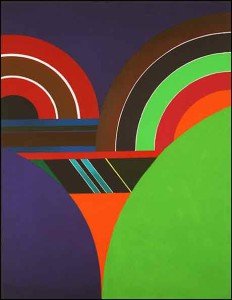I recently had the chance to attend the close of the Blanton’s hosting Moderno, an exhibit showcasing Latin American modern design. Organized by New York’s Americas Society it brought together forward-thinking designs for furniture, textiles, paintings, glass and metalwork.
Navigating through the contexts and biographies I realized, as a North American, how little we are taught of Latin American history, let alone early 20th century diaspora. The artists in the collection were Latin American, they lived and worked in Brazil, Mexico, Venezuela…but for many of them these places were not their first homes. I found the stories of the artists almost more fascinating than the works. Some of the artists were of course native to their countries but almost all were international in some degree, whether having studied in Germany after the war or having fled Germany before the war, having left the Netherlands in protest of colonial wars in Indonesia or having left Cuba for Mexico or Portugal for Brazil. Some of the artists were of Asian descent, either having been born in Argentina of Japanese heritage or having been Chinese-British now active in Mexico.
I found these biographies fascinating and wanted to read more. This is the story of the 20th century and modernity, this diaspora in the face of war, economic and cultural immigration. How have these trajectories influenced art, identity, design and heritage? What does it mean to have Latin American art created by North Americans who left the U.S. for Mexico in the 60’s? What was the impact of Dutch craftsmanship on Brazilian design? What was the impact of having a Venezuelan photographer study in German? I left the exhibit filled with questions.
The painting here Miles Davis – Bitches Brew (III) for example is by Argentinian Kazuka Sakai, born in 1927 to Japanese parents who moved the family to Japan when he was 7 to complete a classical Japanese education. They returned to Argentina in 1951 when he was 24. During the 50’s and early 60’s he was a leading member of the movement Informalismo. After exhibiting in Buenos Aires he moved to New York where he stayed til 1965. After that he moved to Mexico where he lived and worked until the late 70’s. After 1977 he returned to the U.S., exhibiting in Mexico, the U.S., Spain, and Costa Rica.
Stories such as these challenge our notions of identity and influence and reveal how marvelous and energetic the global spread of modernist ideas is. Each of these profiles ask us to reflect on boundaries, the impacts of cultural context and training, and how these artists have these in their work. Global modernisms have been a meeting place, a tool to articulate cultural cross-sections and produce meaningful and rich experiences.

